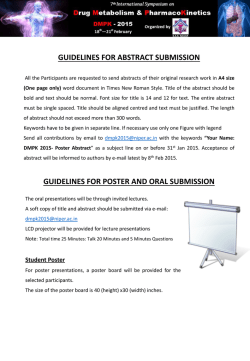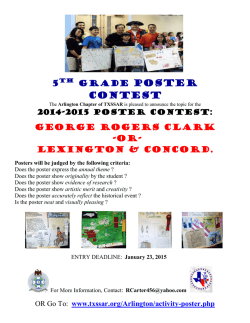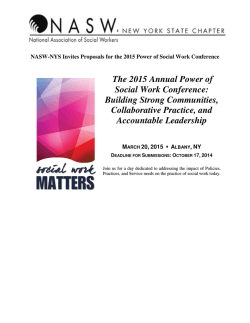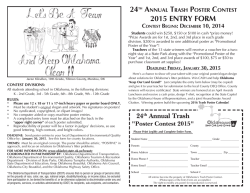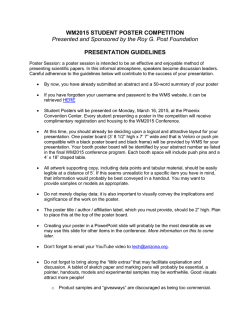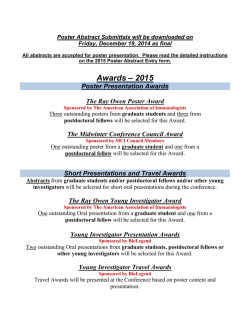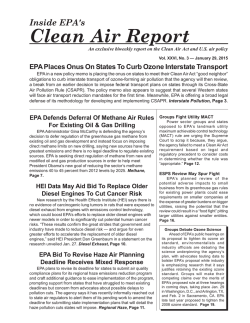
SunWise with Shade Foundation 2015 Poster Contest
SunWise with Shade Foundation 2015 Poster Contest 2014 National Poster Contest Winner Congratulations to Dixon from Texas! Dear Educator, You are invited to participate in the SunWise with Shade Foundation 2015 Poster Contest. Along with the U.S. Environmental Protection Agency’s SunWise program, we are here to provide you with additional educational resources included in this guide. By participating in this contest, your students join more than 167,000 students who have submitted posters over the past twelve years. Plus, 4th -8th grade state winners will receive classroom prizes and will be entered into a national contest for a trip to Washington, DC. The winning teacher in the national contest will receive $500.00. The top five K- 3rd grade entries will receive a Sun Safety Kit. Being sun-safe is important because skin cancer is the most common cancer in the United States, and one in five Americans will develop the disease. By following the SunWise action steps, we can teach children to protect themselves from ultraviolet radiation at a young age, decreasing their chance of developing skin cancer later in life. The activities included in this guide will help you teach your students about sun safety. If you like the sample activities and want a free SunWise tool kit, containing over 50 cross-curricular activities for grades K-8, please sign up at: www.epa.gov/sunwise/becoming.html. Finally, because of the huge number of entries, we must follow strict eligibility criteria. Students must include at least five SunWise actions steps on page 1 of this guide. You will find additional requirements there as well. To see previous winning posters and to learn more about this year’s poster contest and prizes, please visit: www.shadefoundation.org. Best of luck and remember to Limit the Sun, Not the Fun! James Norton Chairman Shade Foundation of America The Shade Foundation logo is a registered trademark of the Shade Foundation. SunWise is a registered trademark of the U.S. EPA. All other trademarks are the property of their respective owners. By sponsoring this Poster Contest , no company is receiving the endorsement of the Shade Foundation or the U.S. EPA. SunWise with Shade Foundation 2015 Poster Contest Table of Contents Introduction ……………………………………………………………………...1 Poster Contest Information ……………………………………………………..2 How to Submit a Poster …………………………………………………………3 SunWise Classroom Activities Activity One (Grades K-2) ………………………………………………………5 Activity Two (Grades 3-5) ……………………………………………………….6 Activity Three (Grades 6-8) ……………………………………………………...7 Introduction: The Importance of Being SunWise While some exposure to sunlight can be enjoyable, too much can be dangerous. Overexposure to ultraviolet (UV) radiation in sunlight can result in a painful sunburn. It can also lead to more serious health effects like skin cancer and cataracts. Children particularly need sun protection education since unprotected sun exposure during youth increases their lifetime risk for skin cancer. Most people are not aware that skin cancer, while largely preventable, is the most common form of cancer in the U.S., with nearly 5 million cases diagnosed annually. By following simple steps, you can still enjoy your time in the sun while protecting yourself from overexposure. SunWise Action Steps: Do not burn Avoid sun tanning and tanning beds Generously apply sunscreen of at least SPF 30+ Wear protective clothing, such as a wide-brimmed hat, sunglasses, and fulllength clothing Seek shade Get vitamin D safely Check the UV Index, a forecast of UV intensity Use extra caution near water, snow, and sand Health Effects of Sun Overexposure: Since the appearance of an “ozone hole” over the Antarctic in the early 1980s, Americans have become aware of the health threats posed by ozone depletion, which decreases the earth’s natural protection from the sun’s harmful UV rays. Understanding these risks and taking sensible precautions will help you enjoy the sun while lowering your chances of sun-related health problems. Some adverse effects of sun overexposure include: Sunburn Melanoma and non-melanoma skin cancer Premature aging and wrinkling of the skin Cataracts and other eye damage UV Index: The UV Index provides a daily forecast of the expected risk of overexposure to the sun. For more information on the UV Index and ozone layer, please visit: www.epa.gov/sunwise. The UV Index was developed by: 1 SunWise with Shade Foundation 2015 Poster Contest Information Create a Poster: Children in kindergarten through 8th grade are eligible to enter the SunWise with Shade Foundation 2015 Poster Contest. Entries are categorized by K-3rd grades and 4th-8th grades. Submitted posters must meet the following criteria (or risk disqualification): Be original and drawn by hand. No copyrighted / trademarked characters or material; Paper size must be 8 ½ x 11 inches; Posters must include at least five Sun Safety Action Steps (see previous page); Attach the official entry form to the back of each submitted poster (see next page); Entries must be received no later than April 1, 2015; and Correct spelling and grammar must be used in the 4th-8th grade category. Posters will judged based on: Ability to show at least five of the Sun Safety Action Steps (as opposed to using words only); Creativity; Originality; and Quality of artwork State Prizes: (Grades 4th-8th) 4th-8th grade state winners will receive Shade Foundation Sun Safety kits for their classrooms. (A limit of 50 kits per classroom) National Prizes: Grades K-3rd Shade Foundation Sun Safety kits for top five entries Grades 4th-8th The national poster contest winner will receive a trip to the award ceremony in Washington, DC and a tour of the U.S. Capitol; and The sponsoring teacher of the national poster contest winner will receive $500.00. Certain restrictions apply. Please see the Shade Foundation website for more details. Prizes are subject to change. For more information, please visit the Shade Foundation’s website: www.shadefoundation.org The U.S. Environmental Protection Agency (EPA) does not endorse any of the sponsors or take part in the procurement of prizes. The entrant understands that the EPA and/or the Shade Foundation intend to reproduce winning posters on the web and in future promotional materials such as the Poster Contest Guide. By submitting a poster, the entrant gives a perpetual, royalty free license to U.S. EPA and the Shade Foundation to copy, distribute, make derivative works, and publicly display the submitted poster. Posters will not be returned. 2 How to Submit a Poster: Teachers: 1. Please complete the upper section of the form and duplicate the form for distribution to your students. 2. Ensure that each student’s name, age, gender, and grade level are provided on the bottom section of the form. All information is required. 3. Attach the completed form to the back of each child’s poster. 4. Do not write any identifying information on the front of the poster. 5. All entries must be received by April 1, 2015 6. Mail poster entries with completed form attached to the back of the poster to: SunWise with Shade Foundation Poster Contest 3220 N Street NW #281 Washington, DC 20007 ------------------------------------------------------------------Poster Contest Entry Form Teacher’s Name: ________________________________ Email: _______________________ School Name: _________________________________________________________________ School Address: _______________________________________________________________ City: _________________________________ State: _________________ Zip: ____________ School Phone Number: _____________________ School Fax: _________________________ Have you entered the contest previously? YES______ NO______ If Yes, what year? _____ Is your school participating in the SunWise program? YES______ NO______ Did you teach sun safety information to students? YES______ NO______ How did you hear about the contest? ______________________________________________ Child’s Name: __________________________________ Age: ________ Grade: _________ Circle One: Girl Boy 3 This page intentionally left blank. 4 Activity One: Speedy Sun Relay Race (Grades K-2) Estimated Time: 30 Minutes Supplies: One set of the following sun-safe and non-sun-safe clothes and items for each team: Long-sleeved shirt (preferably with collar) Long pants (optional) Hats (wide-brimmed, cowboy) Sunglasses Empty bottles of sunscreen, some with SPFs of 30 and higher, some with lower SPFs Shoes (optional) Various other articles of clothing that are not sun-safe, like tank tops, t-shirts, shorts, baseball caps, visors, etc. Note: Make sure that the clothes are large enough for each student to put on and take off easily. Learning Objective: This activity will challenge students to think quickly about sun-safe behavior by selecting correct sun-safe clothes when presented with several options. Assess whether the students learned how these clothes will help protect them from the sun’s harmful UV rays by asking them the following questions: What are three items that the model is wearing that you would pick to protect yourself? Explain why you chose these three items. How many of you dress like the model when you play outside? Why do you think dressing like this is safer for you? Explain why you would take these actions. Directions: 1. Organize the class into teams of five or more and line them up at the start of the racecourse. 2. Place the pile of clothes at the other end of the racecourse. Have each team select one student to be the sun-safe model. This student will stay at the starting point of the race, donning sun-safe clothes. 3. The other team members should each take turns running to the pile of clothes, selecting one item, and bringing it back to the model. The first team to have a completely sun-safe model is the winner. 4. The sun-safe models should be wearing a protective hat, long-sleeved shirt, and sunglasses, and be carrying a bottle of sunscreen with SPF of 30 or higher. 5. Incorrectly dressed models must decide what they are missing, and the other team members must continue bringing back items until the model is sun-safe. This activity is reprinted from the U.S. EPA’s SunWise Tool Kit. 5 Activity Two: Measure Your Shadow (Grades 3-5) Estimated Time: Two to three 15-minute intervals during one day. Supplies: Chalk (a different color for each trip outside) Yardstick / meterstick Learning Objective: The objective of this activity is to demonstrate to students what causes a shadow, how shadows change from morning to evening, and how they can tell by the length of their shadows what times of day they should seek protection from the sun’s harmful UV rays. Directions: Instruct the students to make a chart on a piece of paper to record the time they traced the shadows and size of the shadows. Also, each student should record his/her own height for comparison. The chart will need two columns and three rows. The top of the chart should be labeled “time” and “measurement.” The side of the chart should be labeled “first shadow,” “second shadow,” and “third shadow” (if a third interval is used). Take the students outside two to three times during the day (once around noon). Have students choose a partner. Instruct the students to trace their partner’s shadow using a piece of chalk on the cement surface of the schoolyard. They should begin tracing the shadows from the feet. They should write their names inside their shadows. Students should use the yardstick to measure the length of the shadows each time they trace them. Students should record the measurement and time in their charts. When everyone goes back outside later in the day, have each student stand on the feet of their own shadow and have their partner retrace their new shadow on top of the original. Again they should record the measurement and time in their charts. Questions and Answers: 1. 2. 3. 4. 5. 6. What makes your shadow? The rays of the sun shining on one side of your body generate a shadow that is projected away from your body. Do you always have a measureable shadow? Yes. When the sun is overhead at noon, the projection of the shadow is much shorter than it is during the rest of the day. Is your shadow always the same size? No. Your shadow is long in the early morning and late afternoon and short during midday. How much time passed between your first and last shadow? Students should count the hours and minutes on a watch or clock to find the number. What is the difference between your measurements? Students should subtract to find the answer. What is the shadow rule? “Short shadow, seek shade.” This activity is reprinted from the U.S. EPA’s SunWise Tool Kit. 6 Activity Three: SunWise Surveyor (Grades 6-8) Estimated Time: One to two class periods Supplies: Clipboards (optional) Measuring tapes, yardsticks or metersticks Learning Objective: This activity will raise student awareness of daytime exposure to the sun. Students will focus on the amount of shade provided for their outdoor hour at school, and the importance of providing sun-safe areas on the property. Assess student comprehension by asking students to design a more sun-safe playground (see the “You are the Architect” activity found in the complete kit). Directions: 1. Tell your students that they are surveyors who have been assigned to determine the current availability of shade on your school’s property in order to help school administrators decide if the grounds are sun-safe. 2. Have the class take a survey of the grounds during a period of time when students are present, such as recess or lunchtime. 3. Have the students begin by drawing a scaled map of the school grounds, observing and marking on the map the most popular places where students congregate and play. These play areas can include sports fields, jungle gyms, blacktops, eating areas, and any other places where kids hang out. 4. Now have students survey and mark the parts of the play areas that are covered in shade. 5. Have the students measure the dimensions of the play areas, record their results, and measure the shade-covered portions of these areas. For circular-shaped areas, such as under a tree, students will measure the diameters and calculate the areas of the shady spot, and write down these results as well. Questions and Answers: 1. What is the total area of the play areas on your school’s grounds? Answers will vary. Students will determine this figure using algebraic formulae to calculate the area of each play area, then adding the sums together. A=l*w 2. What is the total area of the portions of those play areas covered by shade? Answers will vary. Students will determine this figure using algebraic formulae to calculate the area of each shade-covered area, then adding the sums together. 3. What percentage of the play area on your school’s grounds is sun-safe? This answer will be determined by dividing the total area of shady spots by the total area of the play areas. 4. How will the shaded play areas change with the movement of the sun? Answers will vary, but should reflect an understanding of the motion of the sun. This activity was adapted from the California Department of Health Services School Shade Protocol, Cancer Prevention and Nutrition Section, and is reprinted from the U.S. EPA’s SunWise Tool Kit. 7
© Copyright 2024

